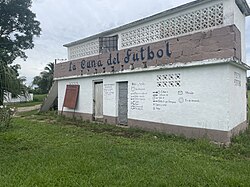Zulueta | |
|---|---|
Village | |
 Building at the Camilo Cienfuegos Stadium | |
| Nickname: La Cuna del Fútbol [1] | |
 Map of Zulueta Popular Council (Red) in Remedios (Orange) in Villa Clara (Yellow) | |
| Coordinates: 22°22′4.51″N79°34′8.47″W / 22.3679194°N 79.5690194°W | |
| Country | Cuba |
| Province | Villa Clara |
| Municipality | Remedios |
| Founded | 1869 |
| Area | |
• Total | 4.579 km2 (1.768 sq mi) |
| Elevation | 180 m (590 ft) |
| Population (2012) [2] | |
• Total | 5,709 |
| Time zone | UTC-5 (EST) |
| Area code | +53-4239 |
Zulueta is a Cuban village and consejo popular ("popular council", i.e. hamlet) of the municipality of Remedios, in Villa Clara Province. It is considered the Cuban birthplace of football [3] and, with a population of ca. 10,000 [4] is the most populated village in the municipality after Remedios.



